Cyclic Loading Performance of Radius-Cut Double Coke-Shaped Strip Dampers
Abstract
1. Introduction
2. Radius-Cut Coke-Shaped Strip Damper
3. Experimental Procedure
3.1. Test Specimens
3.2. Loading Protocol
3.3. Experimental Setup
3.4. Material Properties
4. Experimental Results
4.1. Load-Displacement Relationships
4.2. Initial Stiffness and Yield Strength
4.3. Effective Stiffness and Equivalent Damping
4.4. Energy Dissipation Capacity
4.5. FEM Analysis and Effect of Number of Plastic Hinges
4.6. Failure Modes
5. Conclusions
- The critical section of the coke-shaped strip damper was the radius-cut section where the plastic hinge was located. The observed maximum strength was 65% greater than its theoretical value when using nominal strength and 110% greater than the theoretical value when using the test yield strength. It was confirmed that the membrane effect enhanced the maximum strength when both ends were fixed.
- The target displacement was calibrated by considering actual bolt slip at both ends through trials, and a variety of loading protocols were used to verify damper performance. Moreover, it was confirmed that the coke-shaped strip damper satisfied the performance criteria and exhibited stable behavior, as evidenced by the displacement-force curve.
- During the design of the coke-shaped damper, the total cross-section was increased by 20%. Therefore, the maximum force of COKE2 and COKE4 was greater than that of 1.0 Mp. Moreover, the COKE4 model, which featured an increased number of plastic hinges, yielded faster than the COKE2 and 1.0 Mp models. Thus, it was concluded that ductility increased with the number of plastic hinges.
- COKE2 and COKE4, featuring increased cross-sections, exhibited similar initial stiffnesses, whereas that of the 1.0 Mp model was relatively low. The energy dissipation capacity for the COKE4, COKE2, and 1.0 Mp models increased gradually. The results indicated that both the COKE4 and COKE2 specimens exhibited considerably similar results and that the energy dissipation capacity of the coke-shaped damper was higher than that of the 1.0 Mp damper for all the cycles. However, the highest cumulative energy dissipation was observed for the 1.0 Mp model after 45 cycles. A comparison of ductility and the normalized force confirmed that the maximum load increased as the number of hinges increased, for the same value of ductility.
- In this study, the number of plastic hinges was limited to two and four per section, owing to limitations on the length and construction of the sections. Thus, further studies should consider the effect of multiple plastic hinges on the damping capacity, energy dissipation capacity, and stiffness and ductility of the damper.
Author Contributions
Funding
Conflicts of Interest
References
- Tse, K.T.; Kwok, K.; Tamura, Y. Performance and Cost Evaluation of a Smart Tuned Mass Damper for Suppressing Wind-Induced Lateral-Torsional Motion of Tall Structures. J. Struct. Eng. 2012, 138, 514–525. [Google Scholar] [CrossRef]
- Marshall, J.D.; Charney, F. A hybrid passive control device for steel structures, I: Development and analysis. J. Constr. Steel Res. 2010, 66, 1278–1286. [Google Scholar] [CrossRef]
- Lee, C.-H.; Ryu, J.; Oh, J.; Yoo, C.-H.; Ju, Y.K. Friction between a new low-steel composite material and milled steel for SAFE Dampers. Eng. Struct. 2016, 122, 279–295. [Google Scholar] [CrossRef]
- Silwal, B.; Ozbulut, O.; Michael, R.J. Seismic collapse evaluation of steel moment resisting frames with superelastic viscous damper. J. Constr. Steel Res. 2016, 126, 26–36. [Google Scholar] [CrossRef]
- Kim, J.; Shin, H. Seismic loss assessment of a structure retrofitted with slit-friction hybrid dampers. Eng. Struct. 2017, 130, 336–350. [Google Scholar] [CrossRef]
- Bae, J.; Karavasilis, T.L. Seismic design and assessment of steel frames with visco-plastic dampers. Int. J. Earthq. Impact Eng. 2019, 2, 282–297. [Google Scholar] [CrossRef]
- Hwang, J.-H.; Ock, J.-H.; Kim, Y.; Mauk, J.-W.; Bae, J. The Pushout Test of Seismic Reinforcement System (SRM) Connection that Respond to Earthquake Extensive Level. Int. J. Civ. Eng. 2020, 1–17. [Google Scholar] [CrossRef]
- Ahn, H.-J.; Bae, J.-H.; Kim, Y.-J.; Jung, I.-Y. Cyclic loading test of wall damping system with steel dampers. Adv. Struct. Eng. 2016, 19, 1262–1274. [Google Scholar] [CrossRef]
- Lee, C.-H.; Woo, S.-K.; Ju, Y.K.; Lee, D.-W.; Kim, S.-D. Modified Fatigue Model for Hourglass-Shaped Steel Strip Damper Subjected to Cyclic Loadings. J. Struct. Eng. 2015, 141, 04014206. [Google Scholar] [CrossRef]
- Basu, D.; Reddy, P. A New Metallic Damper for Seismic Resilience: Analytical Feasibility Study. Structures 2016, 7, 165–183. [Google Scholar] [CrossRef]
- Javanmardi, A.; Ibrahim, Z.; Ghaedi, K.; Ghadim, H.B.; Hanif, M.U. State-of-the-Art Review of Metallic Dampers: Testing, Development and Implementation. Arch. Comput. Methods Eng. 2019, 27, 455–478. [Google Scholar] [CrossRef]
- Aghlara, R.; Tahir, M.M. A passive metallic damper with replaceable steel bar components for earthquake protection of structures. Eng. Struct. 2018, 159, 185–197. [Google Scholar] [CrossRef]
- Oh, S.-H.; Kim, Y.-J.; Ryu, H.-S. Seismic performance of steel structures with slit dampers. Eng. Struct. 2009, 31, 1997–2008. [Google Scholar] [CrossRef]
- Kim, Y.J.; Ahn, T.-S.; Bae, J.-H.; Oh, S.-H. Experimental study of using cantilever type steel plates for passive energy dissipation. Int. J. Steel Struct. 2016, 16, 959–974. [Google Scholar] [CrossRef]
- Lee, J.; Kang, H.; Kim, J. Seismic performance of steel plate slit-friction hybrid dampers. J. Constr. Steel Res. 2017, 136, 128–139. [Google Scholar] [CrossRef]
- Chan, R.W.; Albermani, F. Experimental study of steel slit damper for passive energy dissipation. Eng. Struct. 2008, 30, 1058–1066. [Google Scholar] [CrossRef]
- Ghabraie, K.; Chan, R.W.; Huang, X.; Xie, Y.M. Shape optimization of metallic yielding devices for passive mitigation of seismic energy. Eng. Struct. 2010, 32, 2258–2267. [Google Scholar] [CrossRef]
- Kasai, K.; Mita, A.; Kitamura, H.; Matsuda, K.; Morgan, T.A.; Taylor, A.W. Performance of Seismic Protection Technologies during the 2011 Tohoku-Oki Earthquake. Earthq. Spectra 2013, 29, 265–293. [Google Scholar] [CrossRef]
- Lee, D.-S.; Kishiki, S.; Yamada, S.; Ishida, T.; Jiao, Y. Experimental Study of Low-Cycle Fatigue Behavior of a Welded Flange-Bolted Web Connection in Steel Moment-Resisting Frames. Earthq. Spectra 2018, 34, 1829–1846. [Google Scholar] [CrossRef]
- Jones, S.L.; Fry, G.; Engelhardt, M.D. Experimental Evaluation of Cyclically Loaded Reduced Beam Section Moment Connections. J. Struct. Eng. 2002, 128, 441–451. [Google Scholar] [CrossRef]
- Lee, C.-H.; Ju, Y.K.; Min, J.-K.; Lho, S.-H.; Kim, S.-D. Non-uniform steel strip dampers subjected to cyclic loadings. Eng. Struct. 2015, 99, 192–204. [Google Scholar] [CrossRef]
- Lee, C.-H.; Lho, S.-H.; Kim, D.-H.; Oh, J.; Ju, Y.K. Hourglass-shaped strip damper subjected to monotonic and cyclic loadings. Eng. Struct. 2016, 119, 122–134. [Google Scholar] [CrossRef]
- Lee, C.-H.; Kim, J.; Kim, D.-H.; Ryu, J.; Ju, Y.K. Numerical and experimental analysis of combined behavior of shear-type friction damper and non-uniform strip damper for multi-level seismic protection. Eng. Struct. 2016, 114, 75–92. [Google Scholar] [CrossRef]
- Architectural Institute of Korea. KDS 41 17 00. In Seismic Building Design Code; Ministry of Land: Seoul, Korea, 2019. [Google Scholar]
- International System of Units. ASCE/SEI 7-10. In Minimum Design Loads for Buildings and Other Structures; American Society of Civil Engineers: Reston, VA, USA, 2010. [Google Scholar]
- American Society of Civil Engineers. Minimum Design Loads and Associated Criteria for Buildings and Other Structures; American Society of Civil Engineers: Reston, VA, USA, 2017. [Google Scholar]
- FEMA. Prestandard and Commentary for the Seismic Rehabilitation of Buildings; Federal Emergency Management Agency: Washington, DC, USA, 2000.
- Korean Agency for Technology and Standards. KS B 0802. In Method of Tensile Test. for Metallic Materials; Korean Agency for Technology and Standards: Seoul, Korea, 2008. [Google Scholar]
- Korean Agency for Technology and Standards. KS D 3503. In Rolled Steels for General Structure; Korean Agency for Technology and Standards: Seoul, Korea, 2008. [Google Scholar]
- Bae, J.; Lee, C.-H.; Park, M.; Alemayehu, R.W.; Ryu, J.; Ju, Y.K. Modified Low-Cycle Fatigue Estimation Using Machine Learning for Radius-Cut Coke-Shaped Metallic Damper Subjected to Cyclic Loading. Int. J. Steel Struct. 2020, 1–10. [Google Scholar] [CrossRef]
- Korean Building Code. KBC2016: 0306.13.6. In Testing of Damping Devices; Architectural Institute of Korea: Seoul, Korea, 2016. [Google Scholar]
- Kato, B.; Akiyama, H.; Yamanouchi, H. Predictable properties of material under incremental cyclic loading. In Proceedings of the IABSE Symposium-International Association for Bridge and Structural Engineering; International Association for Bridge and Structural Engineering: Lisbon, Portugal, 1973. [Google Scholar]
- Chopra, A.K. Dynamics of Structures: Theory and Applications to Earthquake Engineering, 2nd ed.; Prentice Hall: Upper Saddle River, NJ, USA, 1995. [Google Scholar]
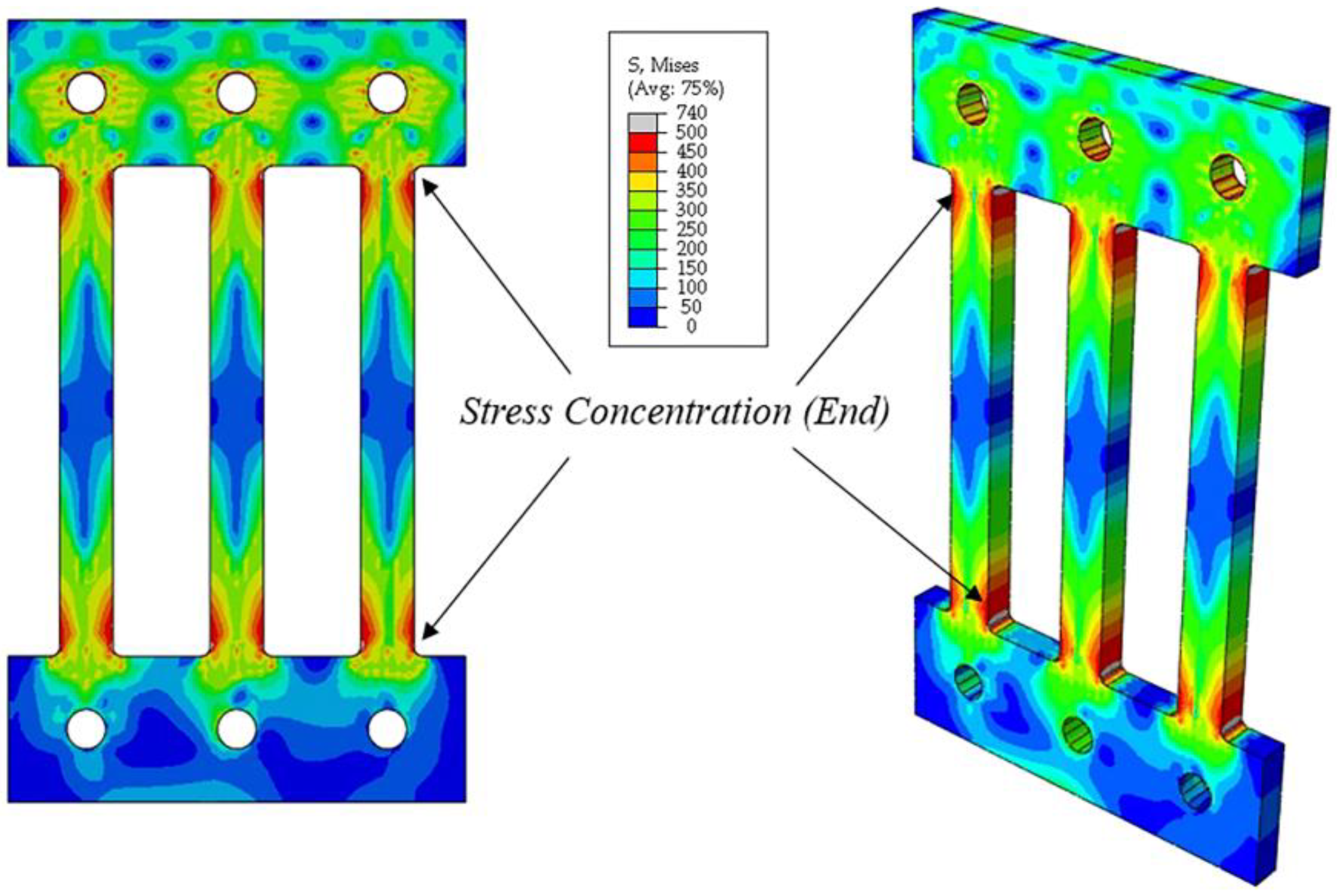
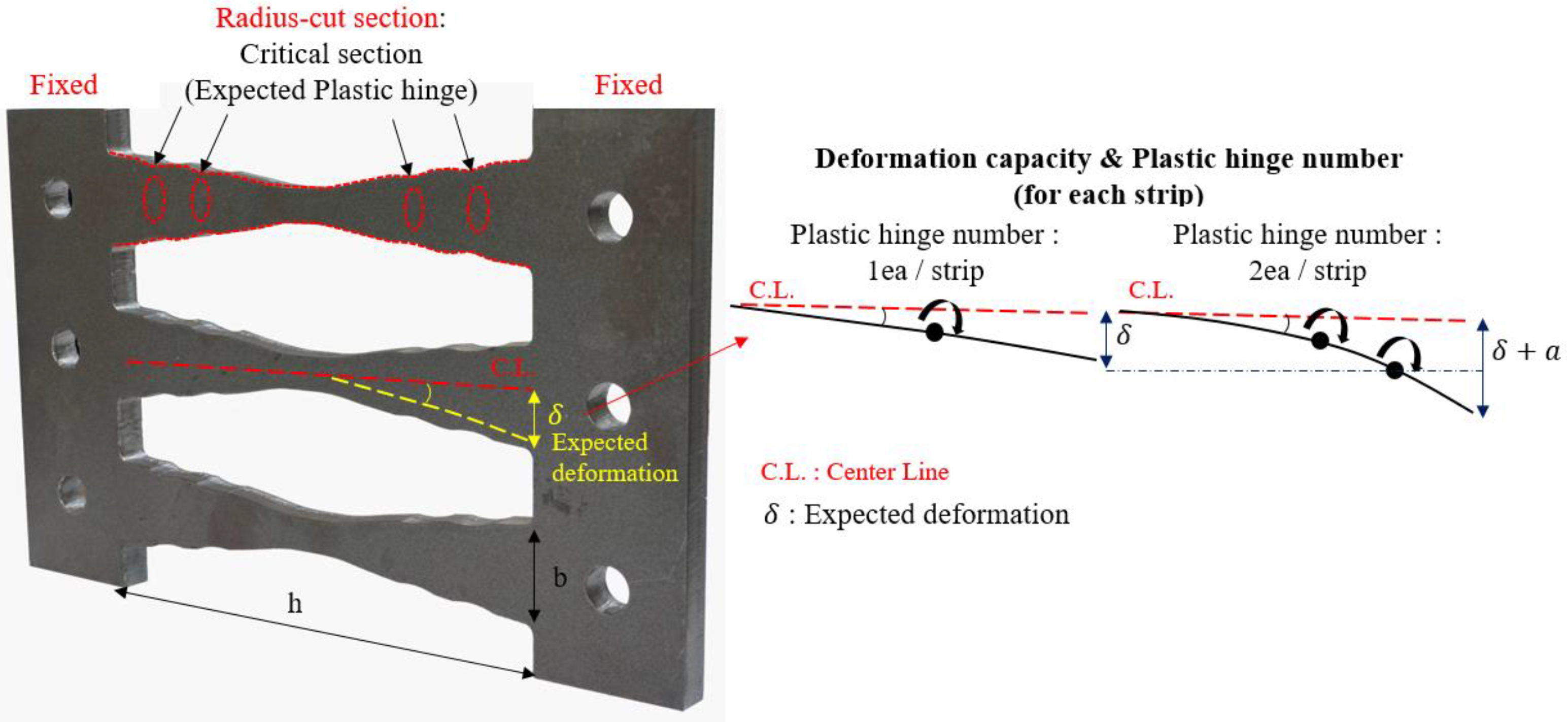
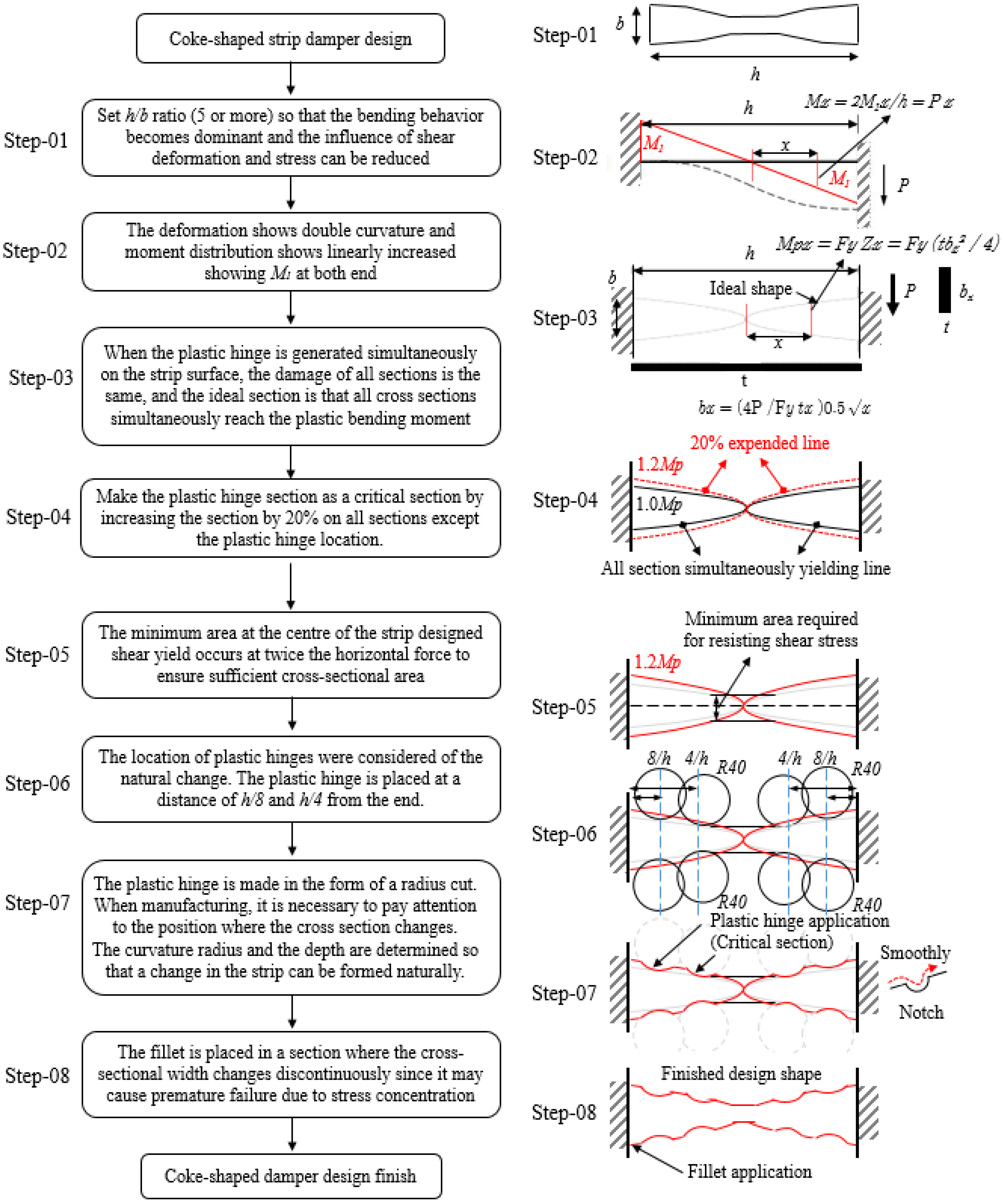


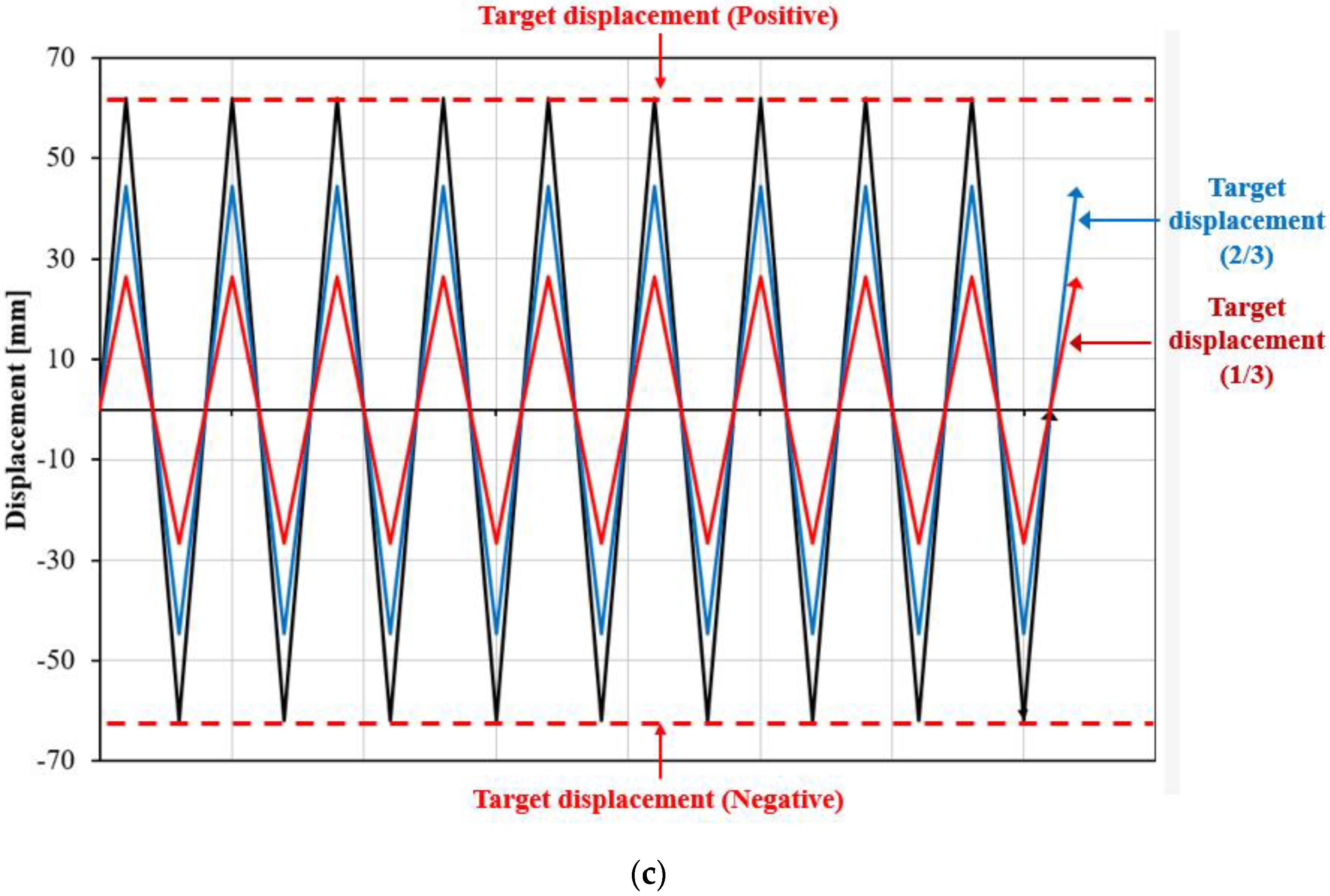
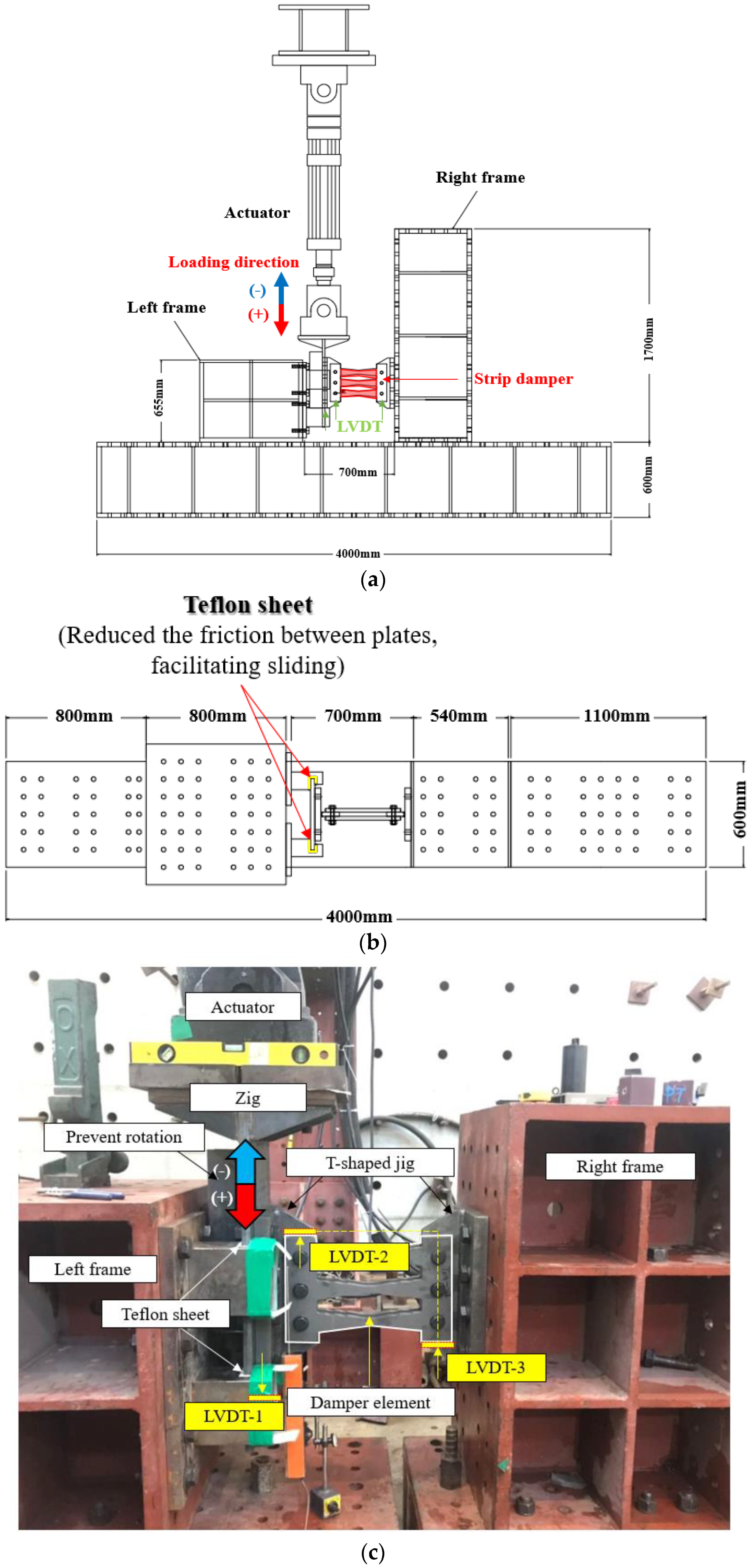
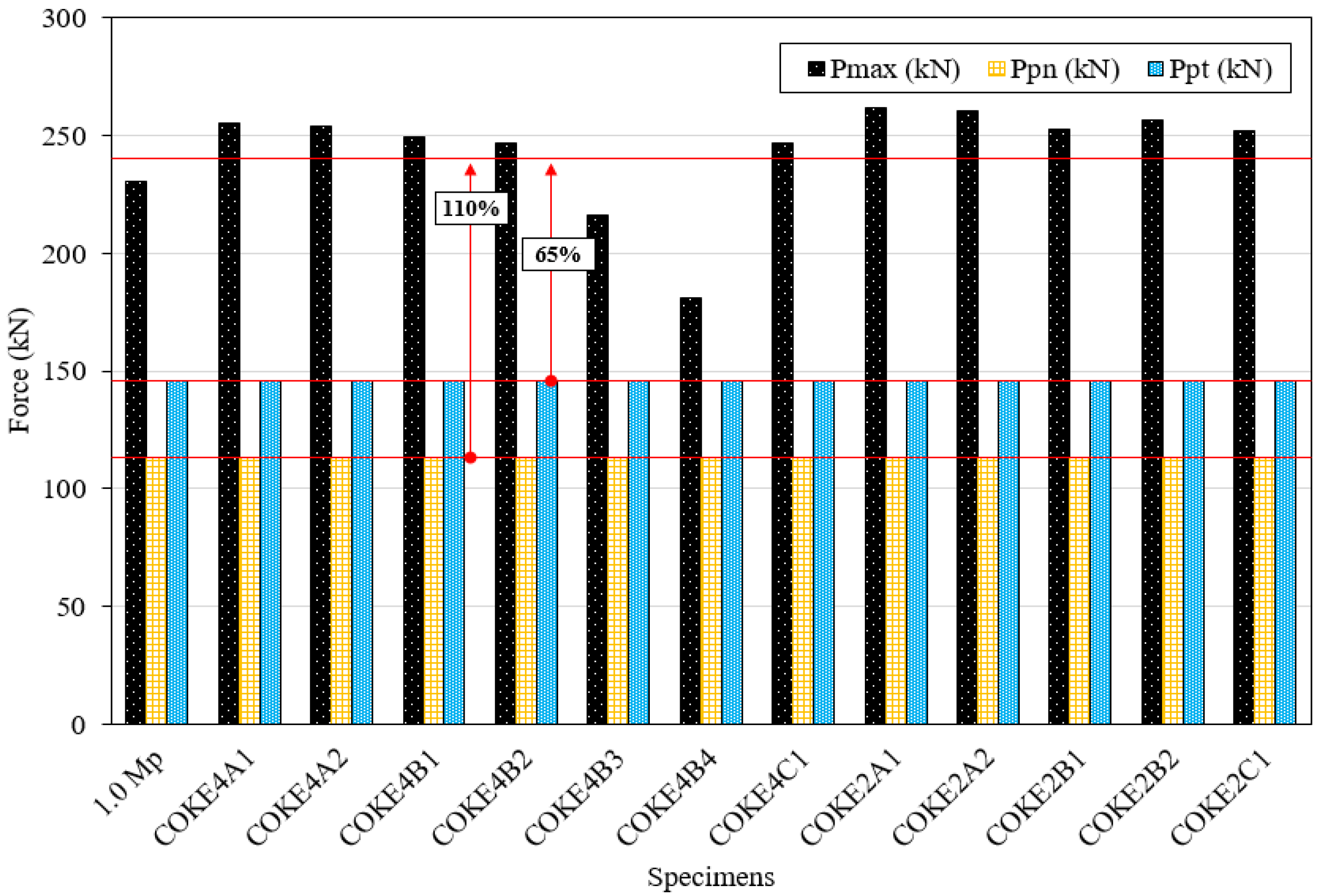
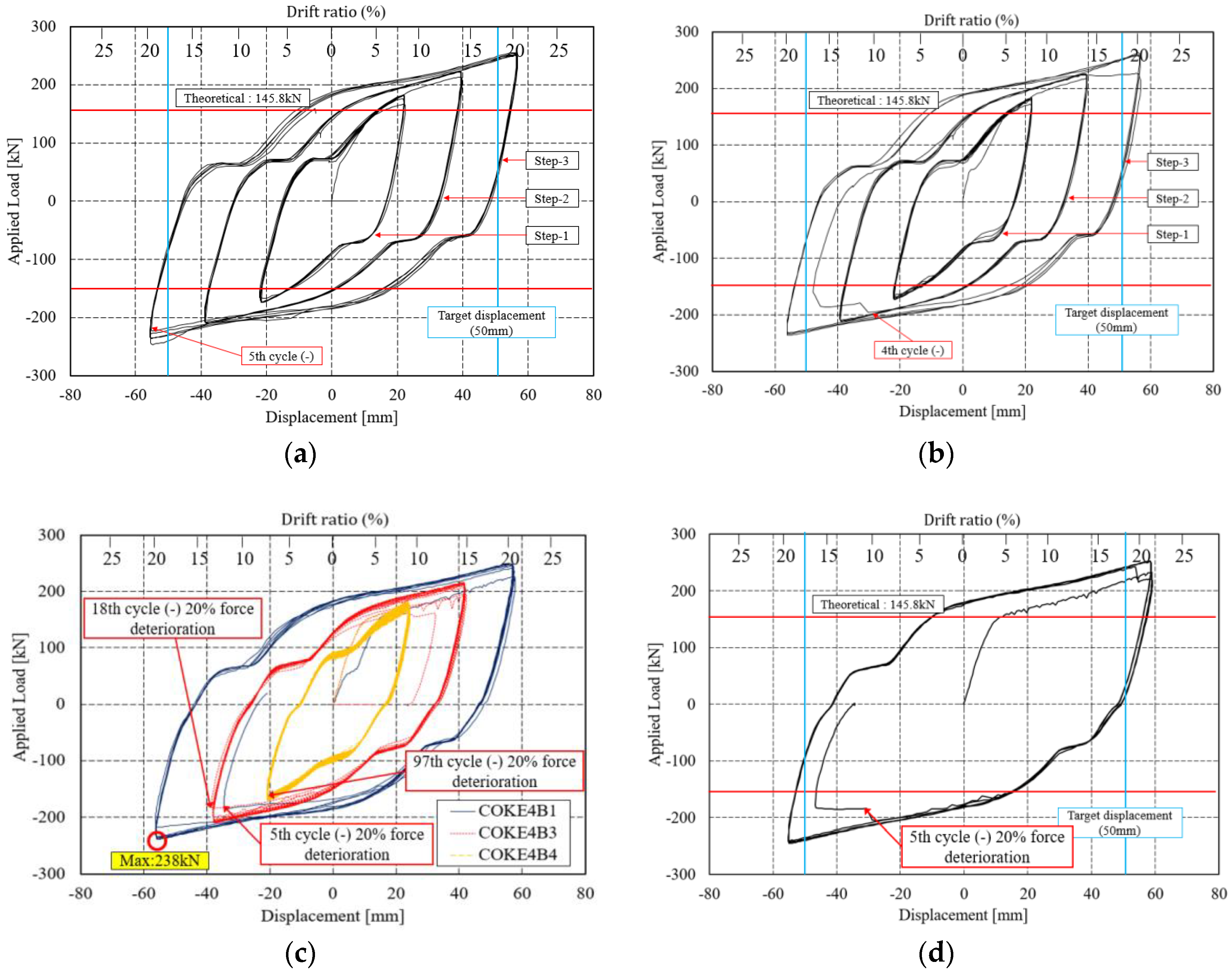
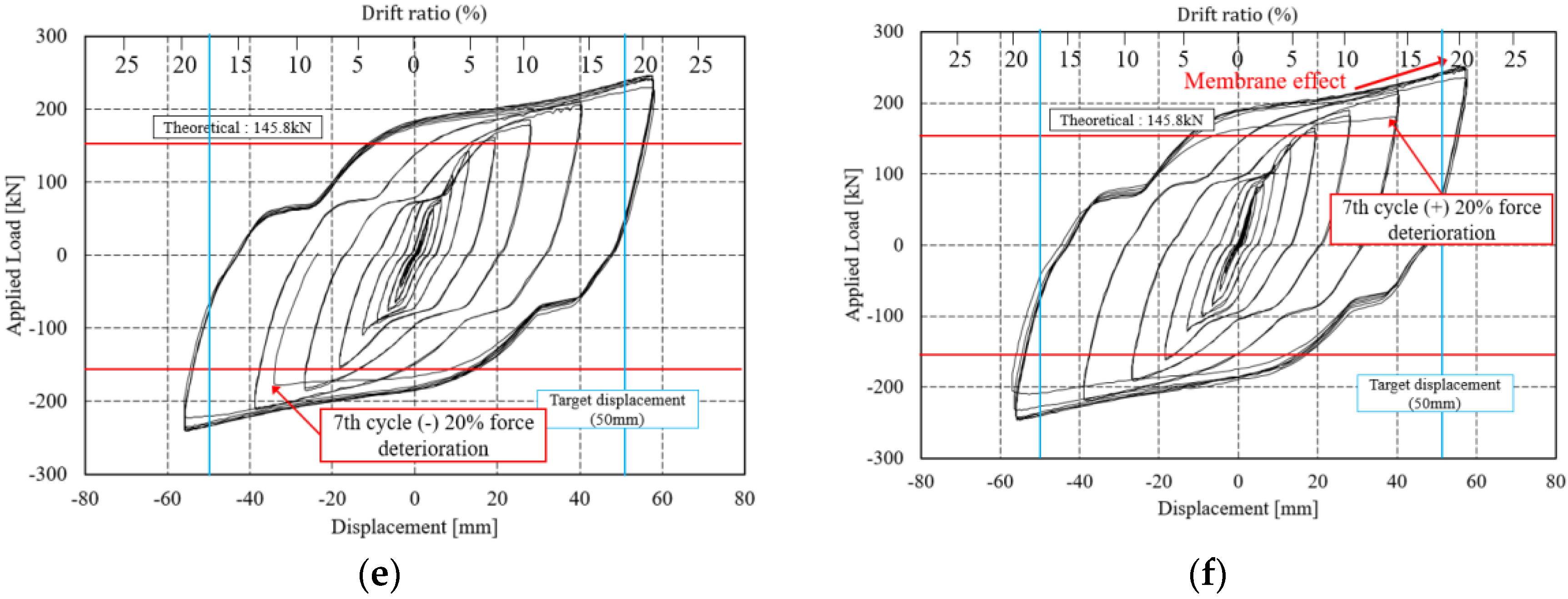

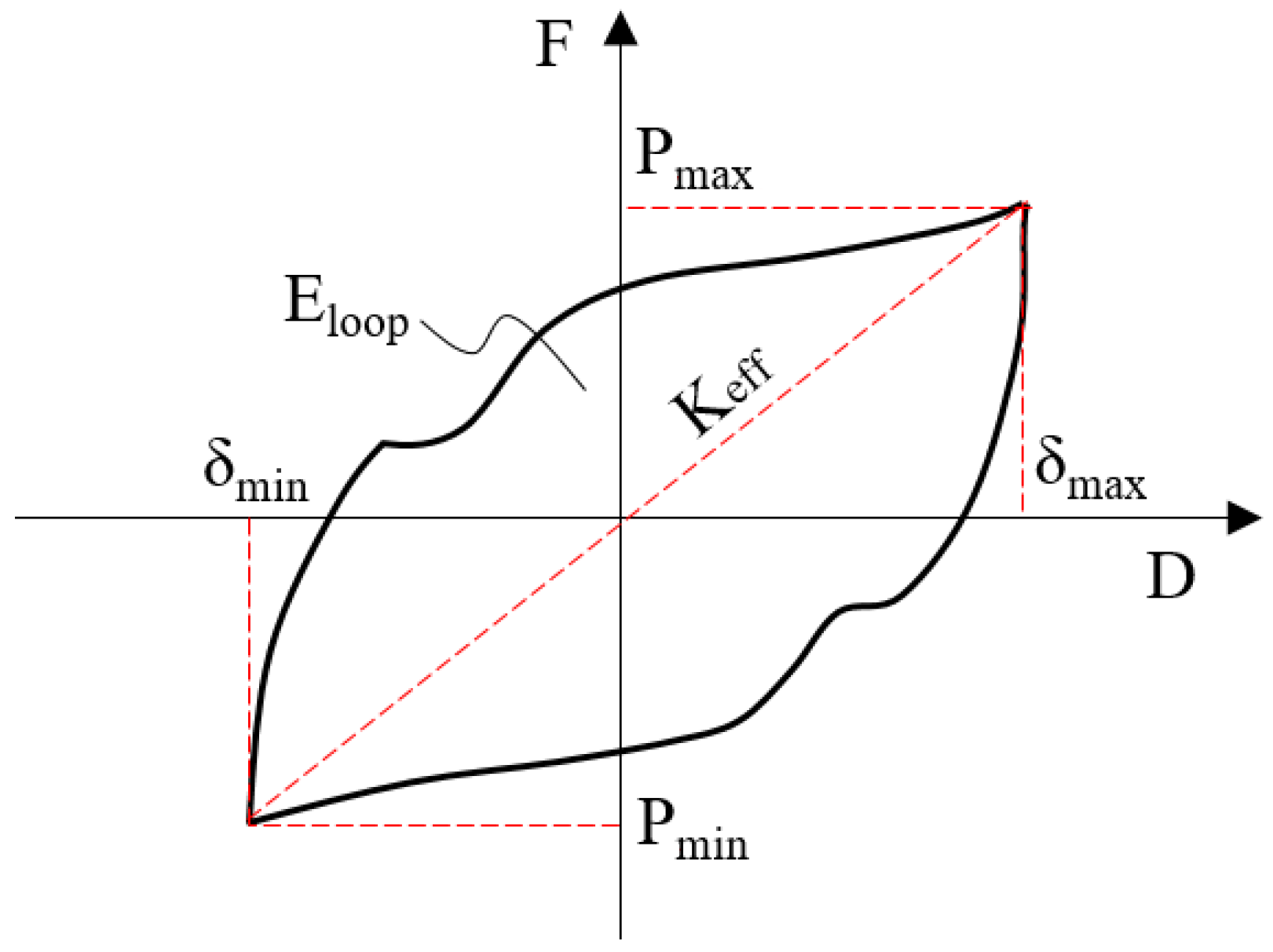

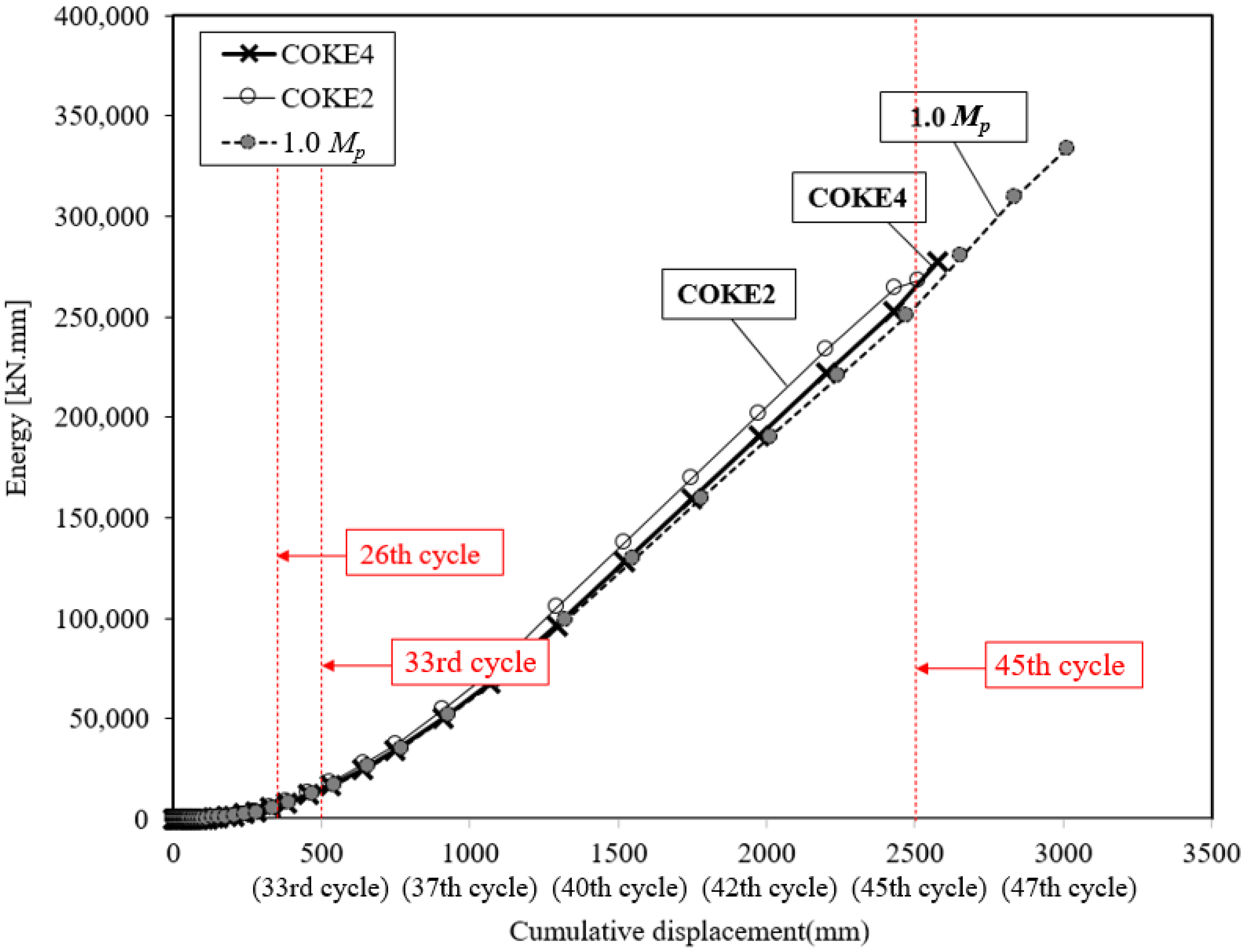
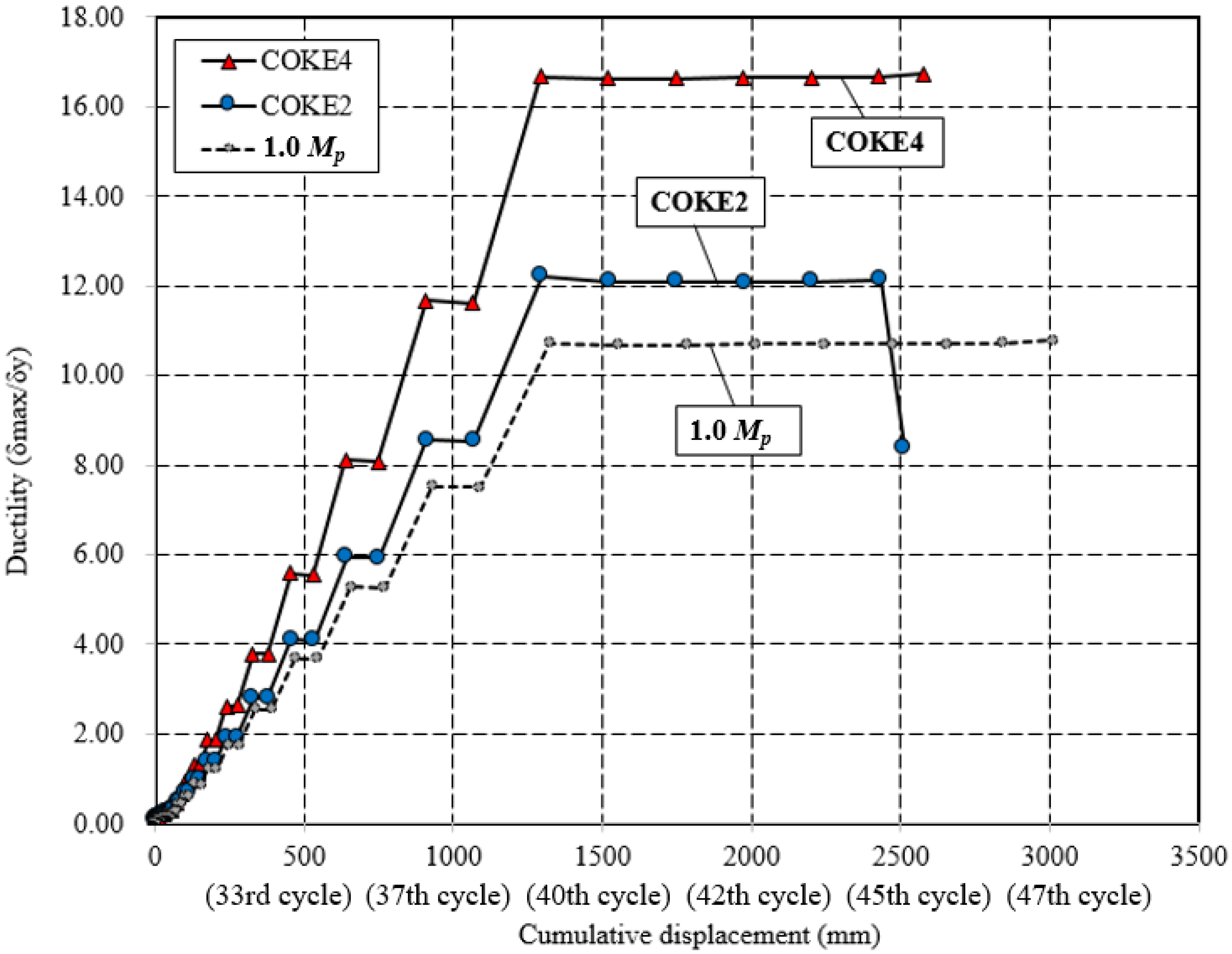
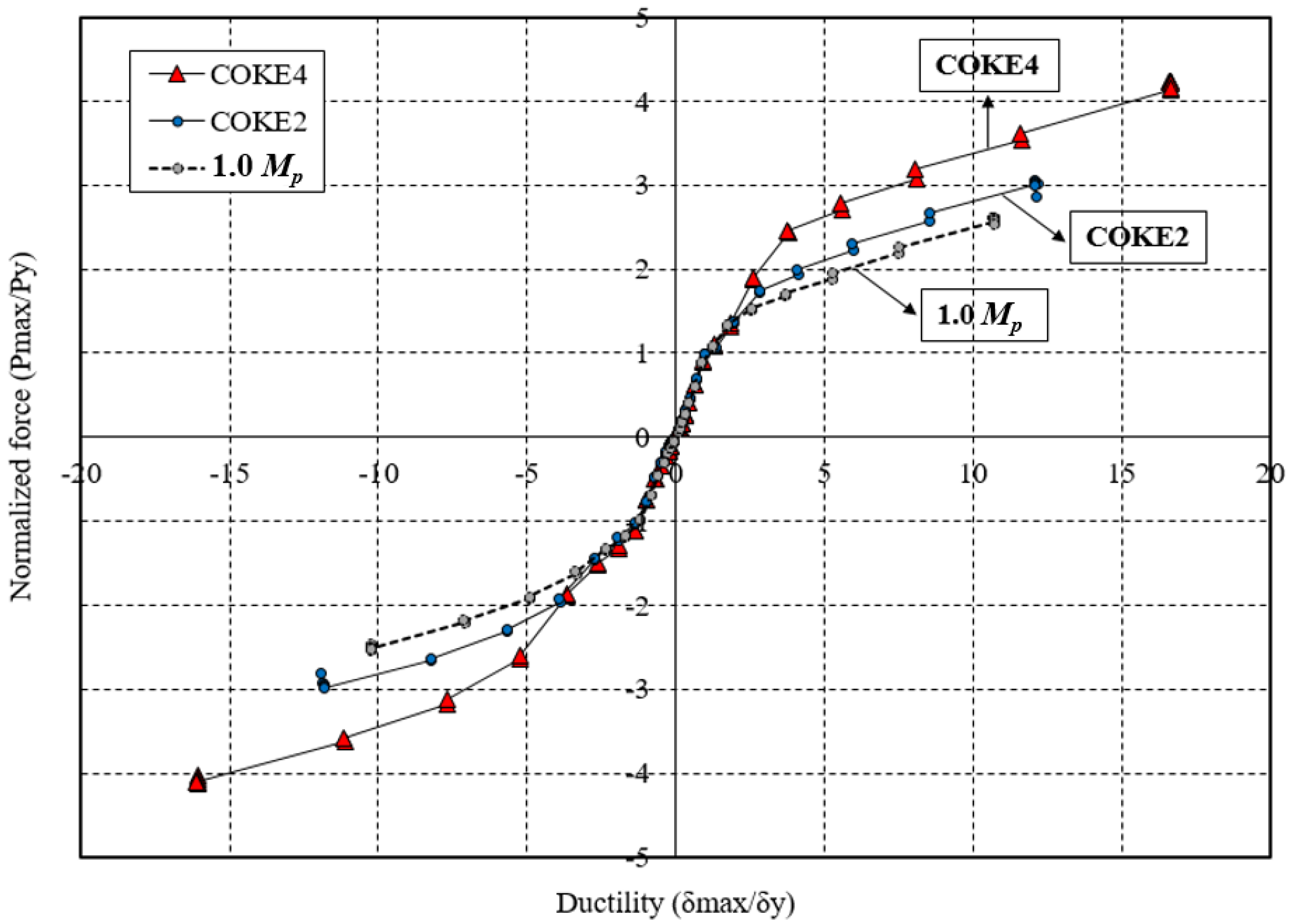

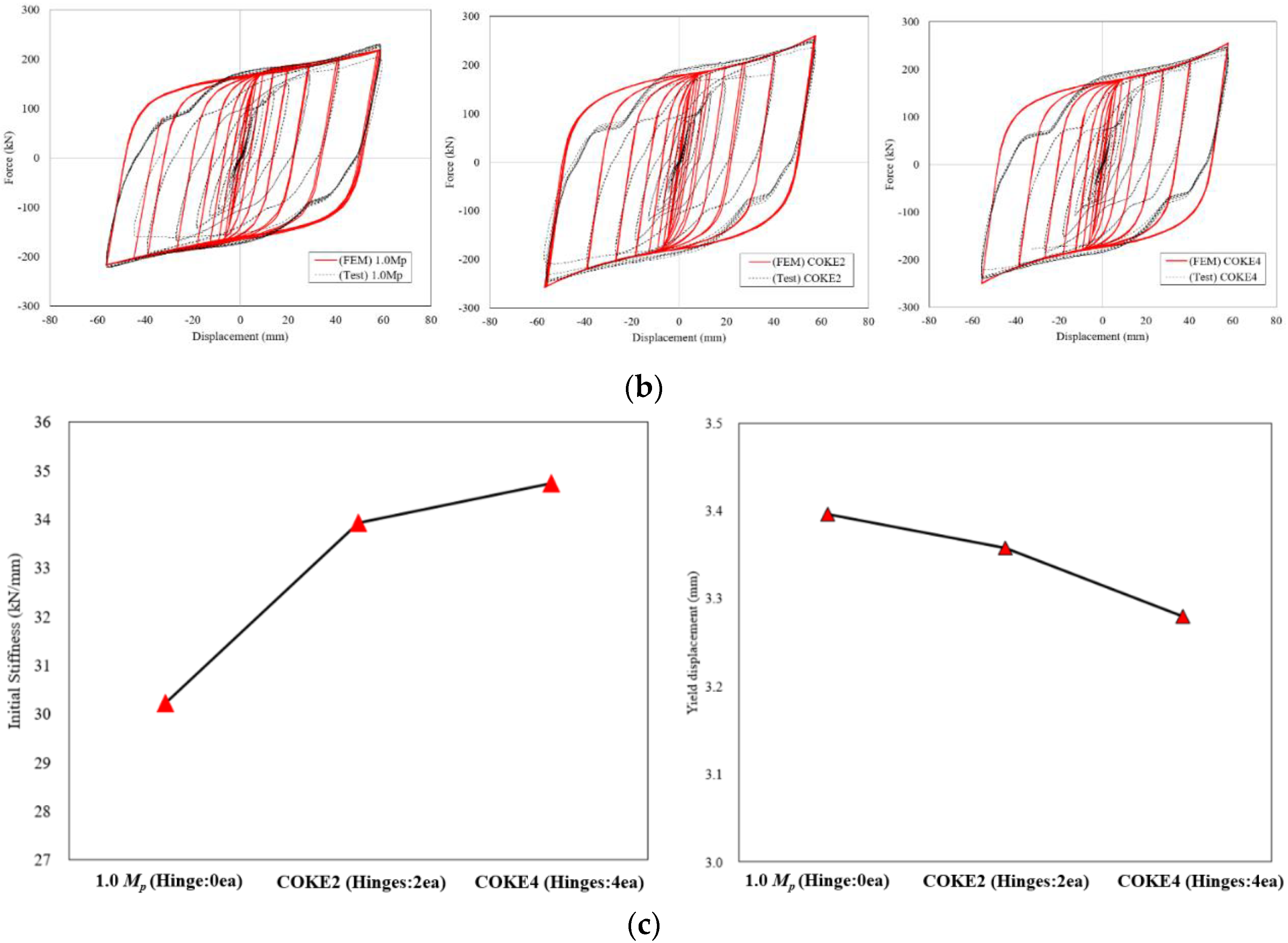
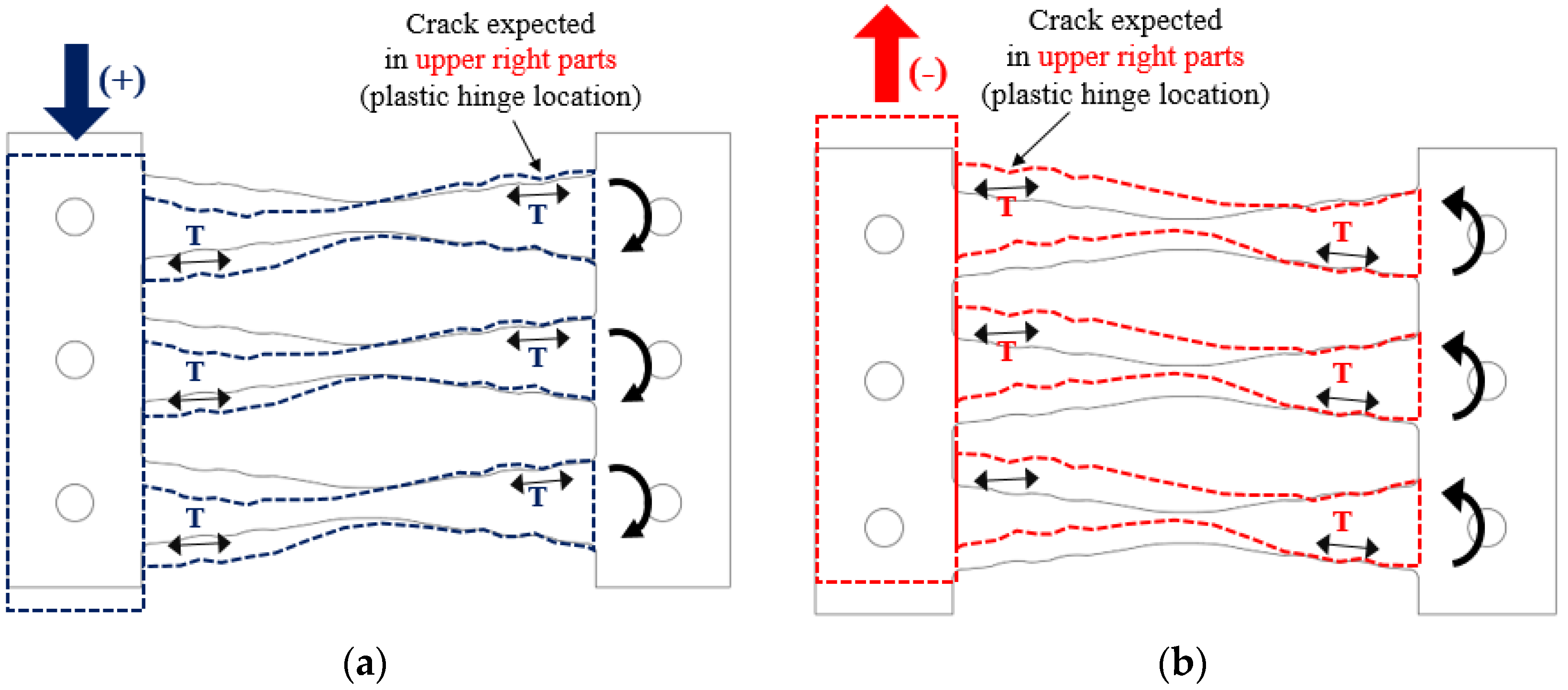



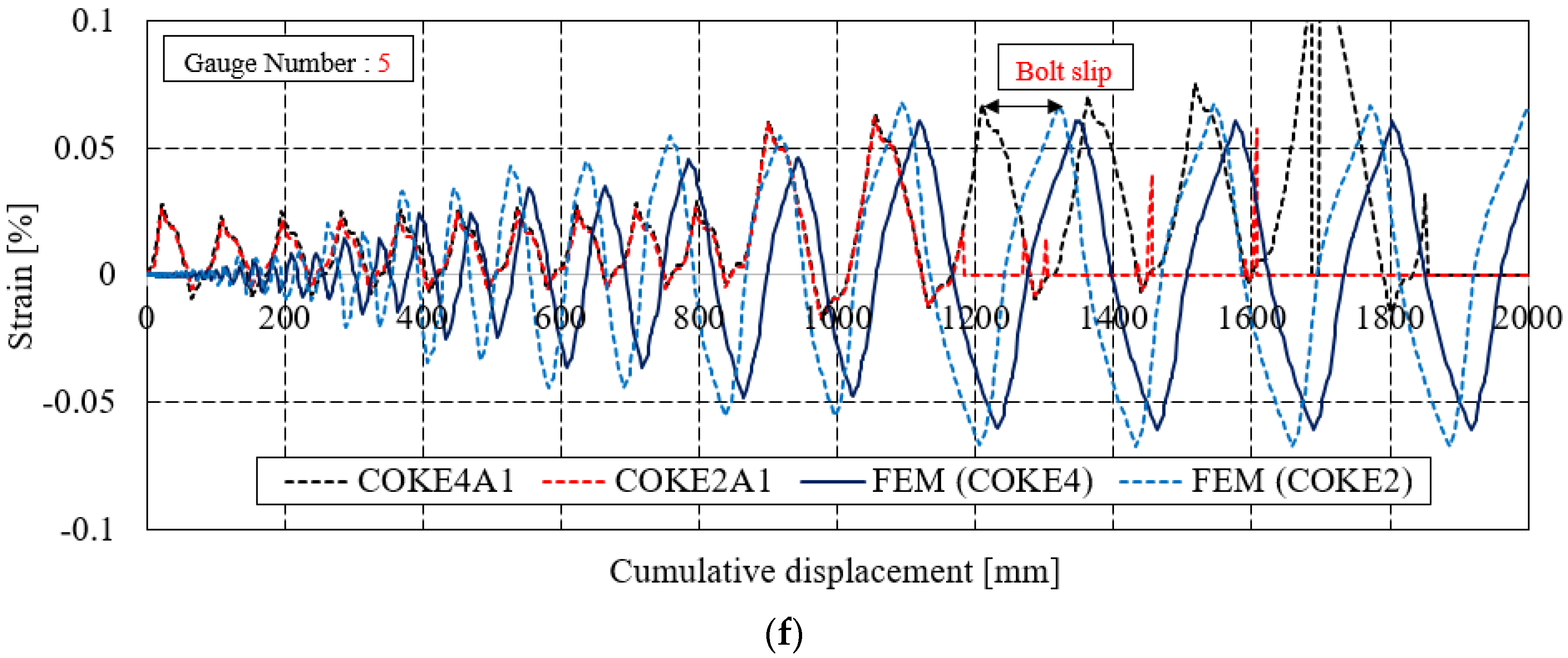
| Specimens | Material | Thickness (mm) | b (mm) | h (mm) | No. of Steel Plates (EA) | Plastic Hinge (EA) | Loading Protocol |
|---|---|---|---|---|---|---|---|
| 1.0 Mp | SS275 | 19 | 45 | 270 | 2 | 0 | FEMA (Incremental) |
| COKE4A1 | SS275 | 19 | 49 (45) | 270 | 2 | 4 | KDS 41 17 00 (2019) |
| COKE4A2 | SS275 | 19 | 49 (45) | 270 | 2 | 4 | KDS 41 17 00 (2019) |
| COKE4B1 | SS275 | 19 | 49 (45) | 270 | 2 | 4 | Constant (62 mm) |
| COKE4B2 | SS275 | 19 | 49 (45) | 270 | 2 | 4 | Constant (62 mm) |
| COKE4B3 | SS275 | 19 | 49 (45) | 270 | 2 | 4 | Constant (44.5 mm) |
| COKE4B4 | SS275 | 19 | 49 (45) | 270 | 2 | 4 | Constant (26.5 mm) |
| COKE4C1 | SS275 | 19 | 49 (45) | 270 | 2 | 4 | FEMA (Incremental) |
| COKE2A1 | SS275 | 19 | 49 (45) | 270 | 2 | 2 | KDS 41 17 00 (2019) |
| COKE2A2 | SS275 | 19 | 49 (45) | 270 | 2 | 2 | KDS 41 17 00 (2019) |
| COKE2B1 | SS275 | 19 | 49 (45) | 270 | 2 | 2 | Constant (62 mm) |
| COKE2B2 | SS275 | 19 | 49 (45) | 270 | 2 | 2 | Constant (62 mm) |
| COKE2C1 | SS275 | 19 | 49 (45) | 270 | 2 | 2 | FEMA (Incremental) |
| Specimen | Fyn (MPa) | Fyt (MPa) | Pmax (kN) | Ppn (kN) | Ppt (kN) | Pmax/Ppn | Pmax/Ppt |
|---|---|---|---|---|---|---|---|
| 1.0 Mp | 265.0 | 341.0 | 230.2 | 113.3 | 145.8 | 2.03 | 1.57 |
| COKE4A1 | 265.0 | 341.0 | 255.3 | 113.3 | 145.8 | 2.25 | 1.75 |
| COKE4A2 | 265.0 | 341.0 | 253.9 | 113.3 | 145.8 | 2.24 | 1.74 |
| COKE4B1 | 265.0 | 341.0 | 249.5 | 113.3 | 145.8 | 2.20 | 1.71 |
| COKE4B2 | 265.0 | 341.0 | 247.1 | 113.3 | 145.8 | 2.18 | 1.69 |
| COKE4B3 | 265.0 | 341.0 | 216.2 | 113.3 | 145.8 | 1.91 | 1.48 |
| COKE4B4 | 265.0 | 341.0 | 181.3 | 113.3 | 145.8 | 1.60 | 1.24 |
| COKE4C1 | 265.0 | 341.0 | 246.8 | 113.3 | 145.8 | 2.18 | 1.69 |
| COKE2A1 | 265.0 | 341.0 | 262.0 | 113.3 | 145.8 | 2.31 | 1.80 |
| COKE2A2 | 265.0 | 341.0 | 260.2 | 113.3 | 145.8 | 2.30 | 1.78 |
| COKE2B1 | 265.0 | 341.0 | 252.7 | 113.3 | 145.8 | 2.23 | 1.73 |
| COKE2B2 | 265.0 | 341.0 | 256.5 | 113.3 | 145.8 | 2.26 | 1.76 |
| COKE2C1 | 265.0 | 341.0 | 251.7 | 113.3 | 145.8 | 2.22 | 1.73 |
© 2020 by the authors. Licensee MDPI, Basel, Switzerland. This article is an open access article distributed under the terms and conditions of the Creative Commons Attribution (CC BY) license (http://creativecommons.org/licenses/by/4.0/).
Share and Cite
Bae, J.; Lee, C.-H.; Park, M.; Alemayehu, R.W.; Ryu, J.; Kim, Y.; Ju, Y.K. Cyclic Loading Performance of Radius-Cut Double Coke-Shaped Strip Dampers. Materials 2020, 13, 3920. https://doi.org/10.3390/ma13183920
Bae J, Lee C-H, Park M, Alemayehu RW, Ryu J, Kim Y, Ju YK. Cyclic Loading Performance of Radius-Cut Double Coke-Shaped Strip Dampers. Materials. 2020; 13(18):3920. https://doi.org/10.3390/ma13183920
Chicago/Turabian StyleBae, Jaehoon, Chang-Hwan Lee, Minjae Park, Robel Wondimu Alemayehu, Jaeho Ryu, Youngsik Kim, and Young K. Ju. 2020. "Cyclic Loading Performance of Radius-Cut Double Coke-Shaped Strip Dampers" Materials 13, no. 18: 3920. https://doi.org/10.3390/ma13183920
APA StyleBae, J., Lee, C.-H., Park, M., Alemayehu, R. W., Ryu, J., Kim, Y., & Ju, Y. K. (2020). Cyclic Loading Performance of Radius-Cut Double Coke-Shaped Strip Dampers. Materials, 13(18), 3920. https://doi.org/10.3390/ma13183920






